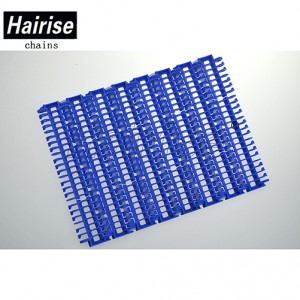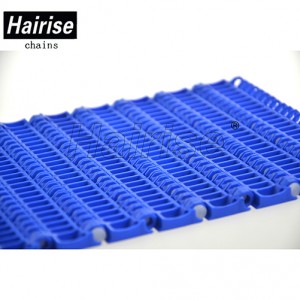Pizzas, snacks, ready meals, meat, fish and chicken – all these food conveying applications need belts that not only work in a freezing environment, but can also move product reliably from room temperature to -30° C (or below). For many years, wire or mesh steel belts were the main solution for industrial freezer food applications. But for well over a decade now, we’ve seen plastic steadily replace steel in this area. Why is this?
Plastic modular belts have many advantages: easy installation, faster repairs and less downtime, no risk of the blackening effect, lower weight and energy consumption and many customization options. Let’s look at these factors in more detail.
1. Easy installation
Whether installing in a spiral, straight-running, or curved layout, plastic modular belts take much less work to set up than steel. This is particularly important given the often very long belt lengths involved (up to 1.6 km in length for spirals).The main reason for this is that plastic modular belts are lighter in weight.
Belt length calculation
It is important to keep in mind that plastic shrinks in freezing conditions. The belt length will usually change after installation, which also affects the height of the catenary sag used to provide optimal belt-to-sprocket engagement (see our blogs on this subject). For example, after installing a plastic modular belt at room temperature, when the belt is operated at -30°C it will shrink by at least half a meter on a spiral of 100 meters, and more if the belt is longer. This can be taken care of, however, through good advance planning.
2. Fast repairs, little downtime
In an ideal world, belts would never get broken or need replacing. The reality is that repairs may well be required. With plastic modular belts, replacing worn or damaged parts is quick and easy. All that’s needed most of the time is a screwdriver – so the repair process minimizes any production losses. By contrast, steel belt repairs are much more complicated, and may involve a welding set, so the process takes considerably more time and inevitably leads to production losses.
3. No risk of blackening
One feature of steel is that it reacts to fatty products by losing carbon, which leaves black deposits on the product and on the belt. Sometime it can even lead to waste. This is called the blackening effect. Plastic, of course, does not suffer from this chemical reaction.
4. Less weight, less energy
A major advantage of plastic modular belts is that particularly in radius applications, they feature low tension throughout the whole system. And as they are lighter, less weight allows smaller motors and therefore lower energy bills. (Of course, if you are retrofitting, you may decide not to replace your original drive, but there will still be some small energy savings.)
5. Quick and easy cleaning
Are there any reasons not to use plastic modular belts? Not really. There is one area, however, that needs particular attention: plastic, particularly POM and PA, is more sensitive than steel to chemical agents, so in harsh cleaning environments it is important to use the right plastic material and the appropriate cleaning agents. Expert advice will avoid any problems.
6. Choice of materials
When it comes to plastic modular belts for industrial freezer applications, there is a choice of two materials: Polyethylene (PE) or Acetal (POM).
- PE is well-suited for low temperature, high impact applications, and has excellent chemical resistance to acids and alkalines. It can be used at temperatures down to -70° C, but is unsuitable for abrasive conditions. NB: Below -40 °C (-40 °F), thermal belt shrinkage requires a sprocket pitch diameter adaptation. Note also that due to strength limitations, PE is not suitable for spiral applications.
- POM is suitable for low temperatures, and offers high strength and a low coefficient of friction (which is lower than on metal belts). It has good chemical resistance to oil and alkalines, but is not suitable for long-term contact with high concentrations of acids and chlorine. Its impact- and cut resistant surface makes it suitable for belts conveying abrasive or sharp products. POM maintains its flexibility from -40° C to +90° C.
7. Individual designs
Thanks to the choice of materials and the vast array of modules and accessories available for plastic modular belts, each belt can be individually designed and assembled to meet the particular needs of its industrial freezer application. Offering long lifetimes, fast maintenance, lower energy consumption, easy cleaning and enhanced reliability and efficiency, plastic modular belts are definitely the way to go.
New installation or retrofit planned? Replace steel by plastic
Are you still using wire or mesh steel belts in your freezer applications, but interested to learn if you can replace these by plastic modular belts? Make the most of our expert knowledge and experience to find the optimal solution for your industrial freezer applications. We’d be happy to help.
You could learn more about us by visiting our website: www.modular-belt.com.

